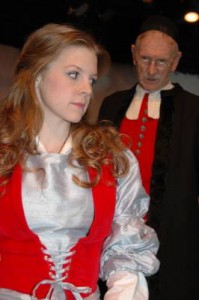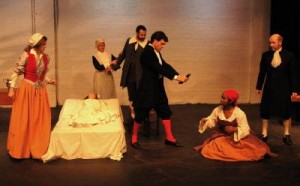
When Arthur Miller’s The Crucible was written in 1953, it was considered an allegory
for the McCarthy “witch hunts,” in which Communism took the place of Satan in
the original Salem Witch Trials of 1692. Today, as religious fundamentalists (of
various creeds) use blind belief in dogma as a way to persecute those they
disagree with, The Crucible stands even stronger than before as an indictment of
religious fanaticism gone amok. 2007 seems an particularly fitting time for a revival
of this Miller classic, and the production currently running at the Matrix more than
does justice to Miller’s words.
Laura Henry has directed with an eye both to performance and to visually
effective staging, the result of which is involving, moving and, even today,
shocking in its depiction of ignorance and mass hysteria.
The year is 1692. At curtain up, we are in a bedroom in the home of Reverend
Samuel Parris, a man living in fear that his “many enemies” will drive him from his
pulpit. His daughter Betty has returned from a night in the woods and now lies in
bed, nearly comatose. Parris soon learns that Betty and some other local girls were
committing the sin of dancing in the forest, and perhaps worse.
The girls’ apparent leader, vixenish Abigail Williams, avows that “there be no blush
about my name,” yet for reasons we do not yet know, eight months ago she was
dismissed from her job at the home of John and Elizabeth Proctor.
Mrs. Ann Putnam, who has lost seven out of eight babies, has begun to suspect
midwife Rebecca Nurse of being an agent of the devil, and the cause of this string
of miscarriages. Mrs. Putnam’s husband Thomas advises Reverend Parris to “strike
out against the devil, and the town will bless you for it.”
The best defense against his waning popularity being a good offence, Parris
decides to take this advice. He is aided and abetted by Abigail who, having seen
her parents killed by Indians, fears nothing but the loss of her lover, John Proctor,
and if accusing Elizabeth of witchcraft is the only way to get back into John’s bed,
then accuse she will.
Though Rebecca warns that “there is prodigious danger in the seeking of loose
spirits,” Parris goes ahead and summons Reverend John Hale, an authority on
witchcraft, and the hunt is on. “The town’s gone wild,” declares a fearful
Elizabeth, predicting rightly that the accused “will hang for witchcraft.”
Only Elizabeth and John seem to understand that this so-called witchcraft is a
fraud, but who will believe them? “The girl’s a saint now,” says John of Abigail,
and anyone who dares to doubt her is sure to be her next victim.
It is at this point that the parallels between the Salem Witch Trials and the
McCarthy Witch Hunt are the strongest, the best way to be exonerated being to
point one’s finger at others, no matter how innocent they may be. Yet none of this
would be happening were religious leaders and judges using their heads rather
than blindly accusing anyone who doubts the veracity of Abigail’s accusations of
being in league with the devil. (The mere reading of books, i.e. seeking knowledge,
is considered a sign of Satan.)
Though Reverend Hale is sharp enough to (eventually) realize the truth, by then it
is too late, for the judges in charge of the trials, particularly Deputy-Governor
Danforth, refuse to stop the proceedings because this would mean admitting
having been wrong from the start. (One cannot help but compare this to the
Bush administration’s stubborn refusal to pull out of Iraq, and Abigail and the other
accusers’ “power trip” is reminiscent of Kenneth Starr’s during the Clinton
impeachment hearings.)
Arthur Miller’s brilliance as a playwright has never been more evident than in The
Crucible, for despite the stilted 1692 English, the historical characters which the
play depicts are as contemporary as those in his modern dramas (Death of a
Salesman, All My Sons, etc.) and as compelling. Despite knowing the play’s
outcome, the audience cannot help hoping that somehow, someone in power will
see the girls’ “pretense,” and end this murderous witch hunt.
At the heart of The Crucible is the story of a love reborn in times of fear and
danger. John Proctor turned to Abigail because, as Elizabeth now realizes, “I
counted myself so plain, so poorly made, no honest love could come to me!…it
were a cold house I kept!” The couple’s relationship is made all the more moving
by the masterful performances of Jeffrey King as John and Emmy nominee Colleen
Flynn as Elizabeth. King just keeps getting stronger and stronger in the role, his final
moments with Flynn absolutely devastating, and Flynn is the kind of actor you
cannot stop looking at, even when she is doing nothing but listen and observe.
Towering work from both.
The ensemble’s performances range from good to outstanding, with special
mention due to Charles Dougherty’s weaselly Reverend Parris, Liz Stoka’s
heartbreaking Mary Warren, Patrick Mulvihill’s crotchety but good-hearted Giles
Corey, and Mary Sabatino’s beatific Rebecca Nurse. In larger roles, Ashley Bell is
very good indeed as the vindictive seductress Abigail, and handsome Brian
Silverman is particularly strong as John Hale. Commanding in the exorcism scene,
his growing awareness of the deception around him is all the more powerful
because of his previous certainty.
Finally Michael Bell makes for an eloquent Danforth. His being mostly on book
bothered me until I read, after curtain calls, that he had assumed this large and
difficult role only one week before the play’s opening the previous weekend, and
my annoyance turned to admiration. (Perhaps an announcement could have
been made before the show.)
Tiffany Williams’ set design is very simple, but combined with her arresting lighting,
it proves to be an effective one, allowing the audience to focus on the
performances. The stage is bare but for items of furniture. The upstage brick wall
has been painted white, the actors casting shadows against it, a particularly
striking effect at the end of Act 1. I’m not sure if late-17th century girls wore the
bright reds and oranges that Abigail and her fellow accusers are dressed in, but
the choice by designer Jennifer Dozier and assistant Paul Alexander McCrae works
in setting them apart from the accused.
For those in search of thought-provoking drama, rare in this month of mostly
cheerful holiday fare, The Crucible is welcome indeed. The play’s run is a short one,
with only one weekend of performances remaining. I highly recommend not
missing this production.
Personal note: The Crucible was my very first play as an actor, at the age of 16,
playing Reverend Parris at Santa Monica High School. Saturday was my very first
time seeing it staged since those three performances, decades ago. Amazingly, it
all came back to me as I sat transfixed by the actors and Miller’s words. I’m so
glad that I got a chance to revisit The Crucible, and to see performed so
beautifully in such a successful production made it all the more memorable.
Matrix Theatre, 7657 Melrose Avenue, Hollywood.
–Steven Stanley
December 15, 2007




 Since 2007, Steven Stanley's StageSceneLA.com has spotlighted the best in Southern California theater via reviews, interviews, and its annual StageSceneLA Scenies.
Since 2007, Steven Stanley's StageSceneLA.com has spotlighted the best in Southern California theater via reviews, interviews, and its annual StageSceneLA Scenies.







 COPYRIGHT 2024 STEVEN STANLEY :: DESIGN BY
COPYRIGHT 2024 STEVEN STANLEY :: DESIGN BY